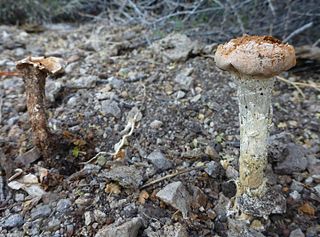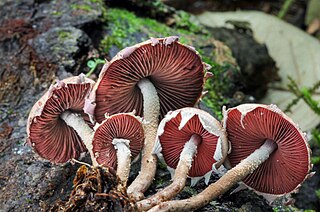Related Research Articles

Lepiota is a genus of gilled mushrooms in the family Agaricaceae. All Lepiota species are ground-dwelling saprotrophs with a preference for rich, calcareous soils. Basidiocarps are agaricoid with whitish spores, typically with scaly caps and a ring on the stipe. Around 400 species of Lepiota are currently recognized worldwide. Many species are poisonous, some lethally so.

The Agaricaceae are a family of basidiomycete fungi and include the genus Agaricus, as well as basidiomycetes previously classified in the families Tulostomataceae, Lepiotaceae, and Lycoperdaceae.

Coprinus is a small genus of mushroom-forming fungi consisting of Coprinus comatus—the shaggy ink cap (British) or shaggy mane (American)—and several of its close relatives. Until 2001, Coprinus was a large genus consisting of all agaric species in which the lamellae autodigested to release their spores. The black ink-like liquid this creates gave these species their common name "ink cap" (British) or "inky cap" (American).

Echinoderma is a genus of fungi in the family Agaricaceae. Its members were for a long time considered to belong to genus Lepiota and the group was then circumscribed by French mycologist Marcel Bon in 1981 as a subgenus of Cystolepiota before he raised it to generic status in 1991.

The Psathyrellaceae are a family of dark-spored agarics that generally have rather soft, fragile fruiting bodies, and are characterized by black, dark brown, rarely reddish, or even pastel-colored spore prints. About 50% of species produce fruiting bodies that dissolve into ink-like ooze when the spores are mature via autodigestion. Prior to phylogenetic research based upon DNA comparisons, most of the species that autodigested were classified as Coprinaceae, which contained all of the inky-cap mushrooms. However, the type species of Coprinus, Coprinus comatus, and a few other species, were found to be more closely related to Agaricaceae. The former genus Coprinus was split between two families, and the name "Coprinaceae" became a synonym of Agaricaceae in its 21st-century phylogenetic redefinition. Note that in the 19th and early 20th centuries the family name Agaricaceae had far broader application, while in the late 20th century it had a narrower application. The family name Psathyrellaceae is based on the former Coprinaceae subfamily name Psathyrelloideae. The type genus Psathyrella consists of species that produce fruiting bodies which do not liquify via autodigestion. Psathyrella remained a polyphyletic genus until it was split into several genera including 3 new ones in 2015. Lacrymaria is another genus that does not autodigest its fruiting bodies. It is characterized by rough basidiospores and lamellar edges that exude beads of clear liquid when in prime condition, hence the Latin reference, lacryma (tears).

Macrolepiota is a genus of white spored, gilled mushrooms of the family Agaricaceae. The best-known member is the parasol mushroom (M. procera). The widespread genus contains about 40 species.

Battarreoides is a fungal genus in the family Agaricaceae. It is a monotypic genus, containing the single species Battarreoides diguetii, found in desert regions of North America. The fungus was originally named Battarreoides potosinus by Teófilo Herrera Suárez in 1951.

Chlamydopus is a genus of fungi in the family Agaricaceae. It was circumscribed by Carlos Luigi Spegazzini in 1898.
Endoptychum is a genus of secotioid fungi in the family Agaricaceae. Like the majority of secotioid taxa, the individual species of Endoptychum are thought to be recent mutations from agaricoid species, hence, Endoptychum is likely not a valid monophyletic genus.
Glyptoderma is a fungal genus in the family Agaricaceae. It is a monotypic genus, containing the single species Glyptoderma coelatum.

Leucoagaricus is a genus of fungi in the family Agaricaceae. Several fungus-growing ants cultivate multiple species for food. The genus contains approximately 90 species.

Melanophyllum is a genus of fungi in the family Agaricaceae. The widespread genus contains four species.
Metrodia is a genus of fungi in the family Agaricaceae. It was circumscribed in 1971 by mycologist Jörg H. Raithelhuber, with M. collybioides as the type species. M. excissa was added to the genus in 1983.
Phlebonema is a fungal genus in the family Agaricaceae. It is a monotypic genus, containing the single species Phlebonema chrysotingens, described by Roger Heim in 1929 from Madagascar. According to the Dictionary of the Fungi, the placement of this little-known genus in the Agaricaceae is uncertain.
Phyllogaster is a fungal genus in the family Agaricaceae. This is a monotypic genus, containing the single species Phyllogaster pholiotoides, found in Ghana and described as new to science in 1969.
Rugosospora is a genus of fungi in the family Agaricaceae. The genus contains two species: R. ochraceobadia, found in Africa, and R. pseudorubiginosa, found in Colombia and Mexico. These species have fruit bodies (mushrooms) with free gills, a white spore print, and a ring on the stipe. Rugosospora was circumscribed by Belgian mycologist Paul Heinemann in 1973.
Xerocoprinus is a fungal genus in the family Agaricaceae. This is a monotypic genus, containing the single species Xerocoprinus arenarius, originally named Coprinus arenarius by Narcisse Théophile Patouillard in 1896. Xerocoprinus was circumscribed by French mycologist René Maire in 1907.

Coniolepiota is a fungal genus in the family Agaricaceae. The genus is monotypic, containing only a single species, Coniolepiota spongodes. It was first described from Thailand, and later also reported from Bangladesh and China.
Eriocybe is a fungal genus in the family Agaricaceae. Circumscribed by mycologist Else Vellinga in 2011, it is a monotypic genus, containing the single species Eriocybe chionea, found in northern Thailand. The genus name is derived from the Ancient Greek words ἔριον, meaning "wool" and κύβη, "head". The specific epithet comes from the Latin translation of the Greek χιόνεος, meaning "snow white".
References
- ↑ Sarwal BM, Locquin MV (1983). "Les champignons de L'Himalaya dans leurs relations avec la flore Eurasiatique". Comptes Rendus du Congrès des Sociétés Savantes de Paris (in French). 108 (2): 191–201. ISBN 9782735500130.